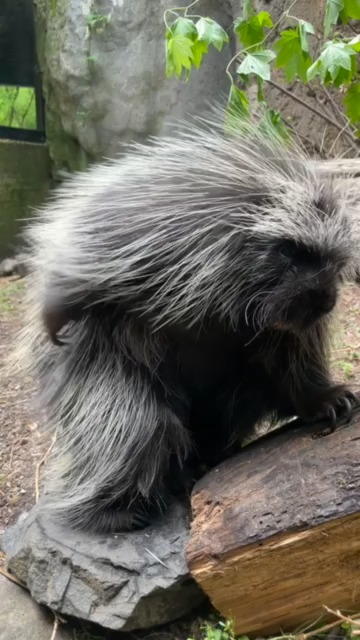- The biology and characteristics of porcupine quills.
- The natural behavior and diet of the porcupine.
- The importance of habitat conservation for porcupines.
- The role of zookeepers and zoo management in porcupine care.
- Insights into wildlife conservation efforts and challenges.
Thistle the porcupine provides a fascinating glimpse into the captivating world of these remarkable creatures. As Thistle pauses from nibbling on his vine maple browse to shed some of his quills, it highlights a unique aspect of porcupine biology. Porcupine quills are not merely protective mechanisms; they are modified hairs that naturally shed over time. Understanding how these quills function and their role in porcupines’ lives offers valuable insights into their biology.
Porcupines are part of the rodent family, and their quills are essentially hair coated in keratin, the same protein found in human hair and nails. Over time, old quills fall out, making way for new growth. This shedding process is akin to how humans lose hair, providing an evergreen defense mechanism. The quills are designed to detach easily upon contact, serving as a deterrent to predators. Educating ourselves on the biology of porcupines helps demystify these animals, promoting compassion and awareness for their protection.
Moving beyond the biology of quills, understanding the natural behavior and diet of porcupines like Thistle adds depth to our knowledge. Porcupines are primarily herbivores, feeding on leaves, twigs, and bark. Their diet includes a variety of vegetation, with a preference for plants like vine maple and other shrubs. This feeding behavior contributes to forest health by promoting vegetation growth and seed dispersal.
In captivity, diligent care is essential to mimic their natural diet and behavior to the greatest extent possible. Zookeepers play a crucial role in providing enrichment activities that stimulate natural behaviors, such as foraging and exploring. Observing how animals like Thistle interact with their environment can inform better management practices, both in captivity and in the wild.
Habitat conservation is another critical component in the survival of porcupines. Their natural habitats are often under threat due to deforestation, urban development, and climate change. Protecting and restoring habitats can have a significant impact on their population stability. Efforts to maintain forest ecosystems are vital for ensuring these creatures continue to thrive.
Zoos and wildlife reserves offer a controlled environment where porcupines are cared for, researched, and protected. The responsibility of zoo management in taking care of porcupines encompasses a wide range of activities, from dietary management to veterinary care. It also includes visitor education, which increases public awareness and fosters a deeper appreciation for wildlife.
Engagement with the public through educational programs can enhance conservation initiatives. By educating people on species like Thistle the porcupine, zoos contribute to global efforts to safeguard biodiversity. Successful conservation strategies often involve collaboration between zoos, conservation organizations, and local communities to address the challenges of habitat loss and climate change.
In recent years, conservation efforts have broadened to include habitat corridors and wildlife passages, allowing porcupines and other animals to move safely between fragmented habitats. Such infrastructure is crucial in preventing genetic isolation and promoting ecological diversity. Adopting sustainable practices and supporting green infrastructure projects can significantly reduce human impact on natural habitats.
In conclusion, the role and behavior of porcupines are integral to understanding broader ecological systems. Thistle’s everyday activities, from eating to shedding quills, offer microcosmic insights into their ecological niche and importance. Through dedicated conservation efforts, habitat preservation, and engagement with the public, we can work toward a future where porcupines and other wildlife coexist harmoniously with humans. Preserving these creatures and their habitats is not just about maintaining biodiversity but also about recognizing the intrinsic value they bring to our world.
*****
Source Description
Thistle the porcupine pauses from nibbling his vine maple browse to give himself a good scratch and shed a bit of his coat. Like our own hair, porcupine quills are modified hairs that shed naturally over time, simply by falling out.
📹: Keeper Kameron


